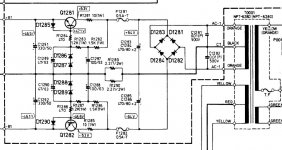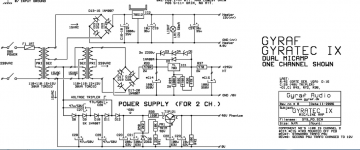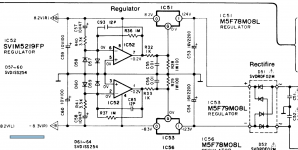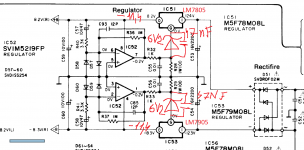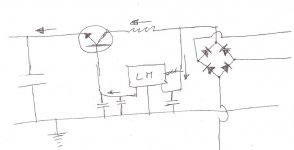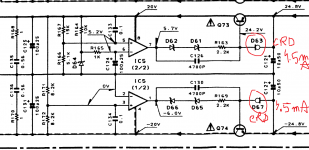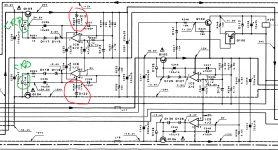Hi ! looking for some information about dual voltage power supplies for preamps in an interview with the Conrad Johnson designer he states that they prefer to realize voltage regulators with discrete parts and not using single chip voltage regulators. In their opinion they can have an impact on the sound ... and not for the good.
Looking then at some preamps schematic i see that in the late '70s and early '80s many of the TOTL solid state preamps actually used voltage regulators made out of discrete parts.
I guess the reason was that this IC regulators were not available ?
They are clearly handy ... but are they also completely fine to use in preamps ?
i would like to get some opinions ... i have a feeling that i was looking at the wrong part of the story ... the preamp circuit ... instead the secret of good sound could lie in the power supply design and construction
I am attaching one schematic just to explain what i have in mind ... more or less
Looking then at some preamps schematic i see that in the late '70s and early '80s many of the TOTL solid state preamps actually used voltage regulators made out of discrete parts.
I guess the reason was that this IC regulators were not available ?
They are clearly handy ... but are they also completely fine to use in preamps ?
i would like to get some opinions ... i have a feeling that i was looking at the wrong part of the story ... the preamp circuit ... instead the secret of good sound could lie in the power supply design and construction
I am attaching one schematic just to explain what i have in mind ... more or less
Attachments
I think you read too much of the "esoteric audio" press instead of good engineering books.
There's really high end audio equipment using op-amps in regulators of all sorts.You can't use them easily in high voltage regulators, but there are a lot of good engineers who don't give a damn on what Conrad Johnson said...By the way...in the late 70's and early 80's there weren't many op-amps on the market, if any...now we have high voltage op-amps too...IC regulators have some op-amps inside...you can use external op-amps too. I used TL783c with valve preamplifiers with no problem:
Gyraf Audio - G9 DIY
There's really high end audio equipment using op-amps in regulators of all sorts.You can't use them easily in high voltage regulators, but there are a lot of good engineers who don't give a damn on what Conrad Johnson said...By the way...in the late 70's and early 80's there weren't many op-amps on the market, if any...now we have high voltage op-amps too...IC regulators have some op-amps inside...you can use external op-amps too. I used TL783c with valve preamplifiers with no problem:
Gyraf Audio - G9 DIY
Attachments
Last edited:
Objectively if we'll look at some parameters we can easy measure (filtering and regulation effect) then IC regulators (like 78xx or LM317) are of cause much (order or two or three orders) better then simple Zener regulators. But there are other parameters like output impedance (frequency and load dependent) and others which are harder to take into account when design (they are non-linear etc).
Possibly unfortunately bad designed IC regulators may worsen the sound I don't know.
Possibly unfortunately bad designed IC regulators may worsen the sound I don't know.
I think if you'll look through this thread, you'll find that Elvee has come up with a brilliant solution for taming three-pin regulators (LM317/337). It performs nearly as well as the hot-shot regulators found elsewhere and it is easily RETRO-FITTABLE to existing designs:
D-Noizator: a magic active noise canceller to retrofit & upgrade any 317-based V.Reg.
It features a 30 db improvement over the stock LM317/337 design in terms of noise ripple rejection, and output impedance.
D-Noizator: a magic active noise canceller to retrofit & upgrade any 317-based V.Reg.
It features a 30 db improvement over the stock LM317/337 design in terms of noise ripple rejection, and output impedance.
I think if you'll look through this thread, you'll find that Elvee has come up with a brilliant solution for taming three-pin regulators (LM317/337). It performs nearly as well as the hot-shot regulators found elsewhere and it is easily RETRO-FITTABLE to existing designs:...
Thanks ! what makes me think is the following comment
Instead i was thinking to something different but of course i do not know how to do it That is using a IC regulator as a voltage reference and leave the transistor to provide the ripple filtering. Can IC regulators be better voltage reference than zener ?Summary: low noise voltage regulator achieved using twelve electronic components, one of which is an integrated circuit
Usually for audio used, no need voltage precision at PSU voltage. For me, high PSRR at least until 100kHz, low noise, and good transient response are more important. I designed several discrete PSU regulator, series and shunt and I share to local audio community. They compared with LM317/337 or 7815/7915. They think my regulators sound better. But still I do not know why they sound better 


You found me outI think you read too much of the "esoteric audio" press instead of good engineering books
If there is an audio product that almost always get excellent reviews and its owners love it, people who listen to it for years ... it must have something good.
I am a solid state guy. While good power amps are not very rare good line preamps are. Conrad Johnson fet preamps series (also those under the Motif name) are a classic in the high end circle.
As you can well image the schematics are not available
From some descriptions it seems that the preamp circuit is very basic and that the power supply is made with discrete parts
So my idea is that maybe is the power supply the reason for the nice "sound" ?
For nice i mean low noise, great detail, dynamics and soundstage.
like ? could it be that they are use but in more complex design also using discrete parts ? i was referring to the very basic circuitThere's really high end audio equipment using op-amps in regulators of all sorts
https://www.circuitstoday.com/wp-content/uploads/2009/10/7815-voltage-regulator.jpg
clearly more in more complex circuits they could be just fine
You can't use them easily in high voltage regulators,

but there are a lot of good engineers who don't give a damn on what Conrad Johnson said...
 still their product sound good ...
still their product sound good ... this is fine i understand that. As soon as they have been available they have been used They are very convenient and cheapBy the way...in the late 70's and early 80's there weren't many op-amps on the market, if any...now we have high voltage op-amps too...IC regulators have some op-amps inside...you can use external op-amps too.
i would really like to stay away from tubes ... there are too many variables like tube qualityI used TL783c with valve preamplifiers with no problem:
Gyraf Audio - G9 DIY
that is my doubtObjectively if we'll look at some parameters we can easy measure (filtering and regulation effect) then IC regulators (like 78xx or LM317) are of cause much (order or two or three orders) better then simple Zener regulators. But there are other parameters like output impedance (frequency and load dependent) and others which are harder to take into account when design (they are non-linear etc).
Possibly unfortunately bad designed IC regulators may worsen the sound I don't know.
Usually for audio used, no need voltage precision at PSU voltage. For me, high PSRR at least until 100kHz, low noise, and good transient response are more important. I designed several discrete PSU regulator, series and shunt and I share to local audio community.
They compared with LM317/337 or 7815/7915.
They think my regulators sound better. But still I do not know why they sound better


Thanks !
 your words confirm what was just a feeling ... now it is more than a feeling ... and I begin dreaming
your words confirm what was just a feeling ... now it is more than a feeling ... and I begin dreaming this point is very important for me because it would change completely my approach
Someone blame for instance opamps for flat sound while instead is the power supply to blame, for not being able to provide a good response to current transients.
An evidence comes from increasing the output cap ... i have used 1000 uF on each rail close to the preamp circuit and it seems that the sound improves (i.e. less noise more dynamics)
Then i was told to stay below 470uF ... 1000uF being too much
Last edited:
I am new in designing voltage regulator but I think the power supply is important. I designed capacitance multiplier for power amplifier. Even, the amplifier has high enough PSRR, but adding capacitance multiplier usually improve the mid and the high frequency. So, it give me feel that high PSRR at high frequency is important.
In the future, I will learn to find the relationship of PSU specification with sound perception. But for now, my approach is high PSRR at high frequency, low noise, and good transient response.
In the future, I will learn to find the relationship of PSU specification with sound perception. But for now, my approach is high PSRR at high frequency, low noise, and good transient response.
Let's say you are looking at PSRR or Zout of a regulator with a precision vector network analyzer -- you set the bandwidth to perhaps 10Hz and sweep from 100Hz to 10MHz -- fine, you can plot these parameters vs frequency -- adequate for most applications.
For audio, perhaps not. The error amplifier in most regulators is not of the same class as a high end TI or ADI. If you put a signal on the output rail and take an FFT you'll see that harmonics show up -- and this is the cause for smearing and veiling, poor translation of percussive instruments.
This was pointed out by a correspondent to the Linear Audio article on comparison of popular regulators, ain't original to me. I was heartened that his comment, and the FFT's I later created matched up with the subjective impression of the listening panel. The Jung-Didden and Per Ander's Sjostrom ranked tops with very little distortion.
For audio, perhaps not. The error amplifier in most regulators is not of the same class as a high end TI or ADI. If you put a signal on the output rail and take an FFT you'll see that harmonics show up -- and this is the cause for smearing and veiling, poor translation of percussive instruments.
This was pointed out by a correspondent to the Linear Audio article on comparison of popular regulators, ain't original to me. I was heartened that his comment, and the FFT's I later created matched up with the subjective impression of the listening panel. The Jung-Didden and Per Ander's Sjostrom ranked tops with very little distortion.
i am attaching the schematic i have in mind to overcome the fact the zener diodes are not good voltage reference
The LM acts only as a voltage reference and drives the bjt base that actually provides voltage to the load
The LM is not providing voltage to the load at all
The LM acts only as a voltage reference and drives the bjt base that actually provides voltage to the load
The LM is not providing voltage to the load at all
Attachments
Last edited:
As far as I always knew, since I was a sixth form student back in 1985, Zener diodes are the foundation of voltage references. If you want more precision, supply a reference Zener diode through a constant current source and use a buffer amplifier to avoid loading it. One of the best, with regards to temperature stability, I remember, is a 6.8V Zener diode which has zero temperature coefficient.
Last edited:
Where did this thread get born? In vacuum? Never heard of the countless discussions about audibility of various PS approaches? Passive vs active, discrete vs integrated, series vs shunt?
Seriously?
CJ and the other dinosaurs ARC are great examples for audio conservatism. Took them 30 years to figure out that nfb is counterproductive in a preamp, just pathetic. In another 30 they may even discover shunt regulation.
Seriously?
CJ and the other dinosaurs ARC are great examples for audio conservatism. Took them 30 years to figure out that nfb is counterproductive in a preamp, just pathetic. In another 30 they may even discover shunt regulation.
^ That's not a good way at all. You are throwing away the the regulation of the chip because the pass transistor is not within any feedback loop plus you are getting a slightly lower output voltage than the chip alone. You also need a higher overhead for the circuit to work properly.
Also some regulators need a minimum load current (particularly some negative ones).
With anything like this you need to define your own requirements first and then see if those requirements can be met with an off the shelf part or, whether you really do need to go further with a dedicated design to get the specification you want.
Also some regulators need a minimum load current (particularly some negative ones).
With anything like this you need to define your own requirements first and then see if those requirements can be met with an off the shelf part or, whether you really do need to go further with a dedicated design to get the specification you want.
it is stated in the art of electronics that the 6.0v zener has zero tempco but if you look in some manufacturer's datasheet you see that the 5.1v is the ov tempco...As far as I always knew, since I was a sixth form student back in 1985, Zener diodes are the foundation of voltage references. If you want more precision, supply a reference Zener diode through a constant current source and use a buffer amplifier to avoid loading it. One of the best, with regards to temperature stability, I remember, is a 6.8V Zener diode which has zero temperature coefficient.
anything between 5.1 and 6.2 will do the job.
they used CRD in the past for zener regulation:
https://www.datasheets360.com/pdf/5903155689177736882
Attachments
Last edited:
- Home
- Amplifiers
- Power Supplies
- Are you really fine with IC voltage regulators ?
